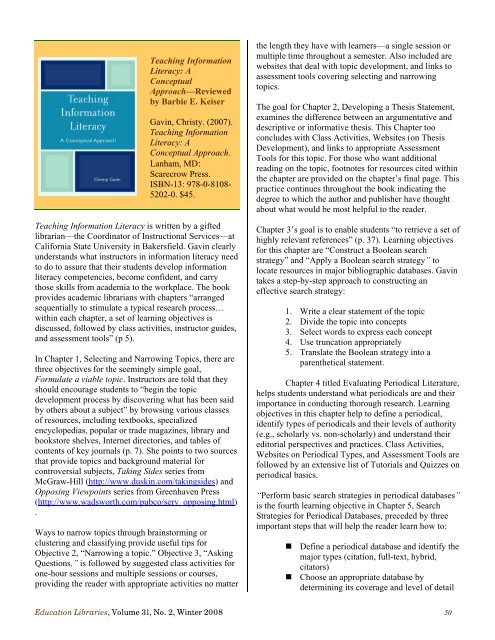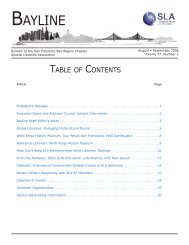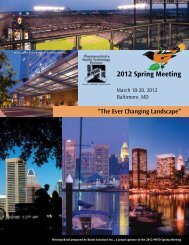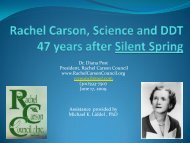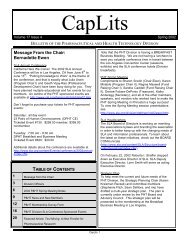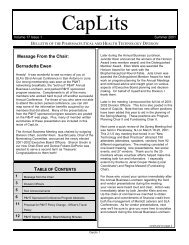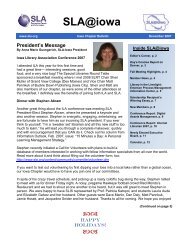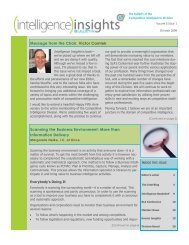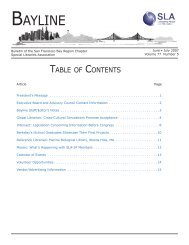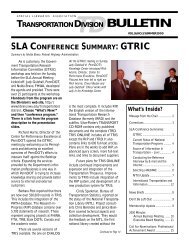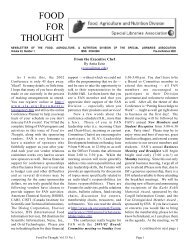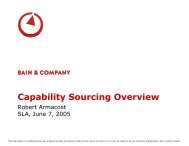Education Libraries - Special Libraries Association
Education Libraries - Special Libraries Association
Education Libraries - Special Libraries Association
You also want an ePaper? Increase the reach of your titles
YUMPU automatically turns print PDFs into web optimized ePapers that Google loves.
Teaching Information<br />
Literacy: A<br />
Conceptual<br />
Approach—Reviewed<br />
by Barbie E. Keiser<br />
Gavin, Christy. (2007).<br />
Teaching Information<br />
Literacy: A<br />
Conceptual Approach.<br />
Lanham, MD:<br />
Scarecrow Press.<br />
ISBN-13: 978-0-8108-<br />
5202-0. $45.<br />
Teaching Information Literacy is written by a gifted<br />
librarian—the Coordinator of Instructional Services—at<br />
California State University in Bakersfield. Gavin clearly<br />
understands what instructors in information literacy need<br />
to do to assure that their students develop information<br />
literacy competencies, become confident, and carry<br />
those skills from academia to the workplace. The book<br />
provides academic librarians with chapters “arranged<br />
sequentially to stimulate a typical research process…<br />
within each chapter, a set of learning objectives is<br />
discussed, followed by class activities, instructor guides,<br />
and assessment tools” (p 5).<br />
In Chapter 1, Selecting and Narrowing Topics, there are<br />
three objectives for the seemingly simple goal,<br />
Formulate a viable topic. Instructors are told that they<br />
should encourage students to “begin the topic<br />
development process by discovering what has been said<br />
by others about a subject” by browsing various classes<br />
of resources, including textbooks, specialized<br />
encyclopedias, popular or trade magazines, library and<br />
bookstore shelves, Internet directories, and tables of<br />
contents of key journals (p. 7). She points to two sources<br />
that provide topics and background material for<br />
controversial subjects, Taking Sides series from<br />
McGraw-Hill (http://www.duskin.com/takingsides) and<br />
Opposing Viewpoints series from Greenhaven Press<br />
(http://www.wadsworth.com/pubco/serv_opposing.html)<br />
.<br />
Ways to narrow topics through brainstorming or<br />
clustering and classifying provide useful tips for<br />
Objective 2, “Narrowing a topic.” Objective 3, “Asking<br />
Questions,” is followed by suggested class activities for<br />
one-hour sessions and multiple sessions or courses,<br />
providing the reader with appropriate activities no matter<br />
the length they have with learners—a single session or<br />
multiple time throughout a semester. Also included are<br />
websites that deal with topic development, and links to<br />
assessment tools covering selecting and narrowing<br />
topics.<br />
The goal for Chapter 2, Developing a Thesis Statement,<br />
examines the difference between an argumentative and<br />
descriptive or informative thesis. This Chapter too<br />
concludes with Class Activities, Websites (on Thesis<br />
Development), and links to appropriate Assessment<br />
Tools for this topic. For those who want additional<br />
reading on the topic, footnotes for resources cited within<br />
the chapter are provided on the chapter’s final page. This<br />
practice continues throughout the book indicating the<br />
degree to which the author and publisher have thought<br />
about what would be most helpful to the reader.<br />
Chapter 3’s goal is to enable students “to retrieve a set of<br />
highly relevant references” (p. 37). Learning objectives<br />
for this chapter are “Construct a Boolean search<br />
strategy” and “Apply a Boolean search strategy” to<br />
locate resources in major bibliographic databases. Gavin<br />
takes a step-by-step approach to constructing an<br />
effective search strategy:<br />
1. Write a clear statement of the topic<br />
2. Divide the topic into concepts<br />
3. Select words to express each concept<br />
4. Use truncation appropriately<br />
5. Translate the Boolean strategy into a<br />
parenthetical statement.<br />
Chapter 4 titled Evaluating Periodical Literature,<br />
helps students understand what periodicals are and their<br />
importance in conducting thorough research. Learning<br />
objectives in this chapter help to define a periodical,<br />
identify types of periodicals and their levels of authority<br />
(e.g., scholarly vs. non-scholarly) and understand their<br />
editorial perspectives and practices. Class Activities,<br />
Websites on Periodical Types, and Assessment Tools are<br />
followed by an extensive list of Tutorials and Quizzes on<br />
periodical basics.<br />
“Perform basic search strategies in periodical databases”<br />
is the fourth learning objective in Chapter 5, Search<br />
Strategies for Periodical Databases, preceded by three<br />
important steps that will help the reader learn how to:<br />
� Define a periodical database and identify the<br />
major types (citation, full-text, hybrid,<br />
citators)<br />
� Choose an appropriate database by<br />
determining its coverage and level of detail<br />
<strong>Education</strong> <strong>Libraries</strong>, Volume 31, No. 2, Winter 2008 50


